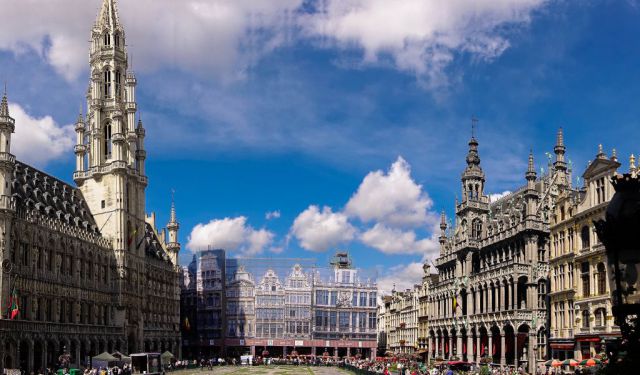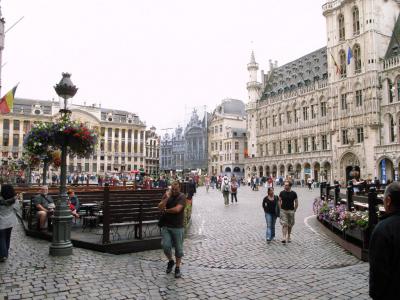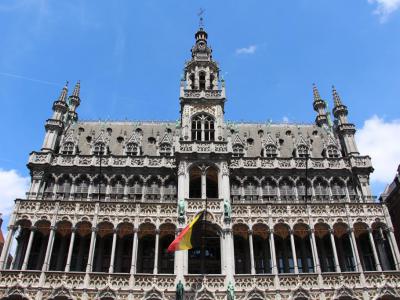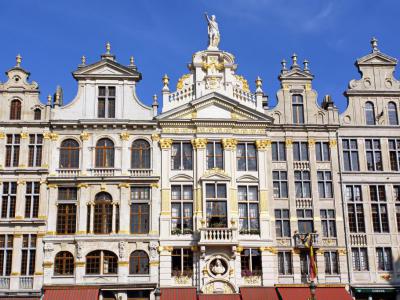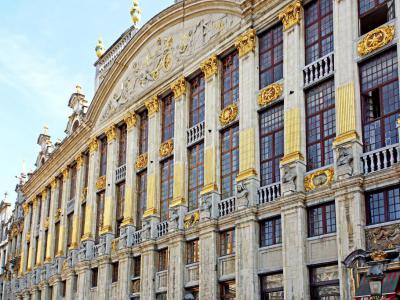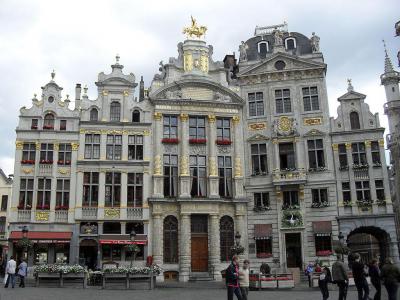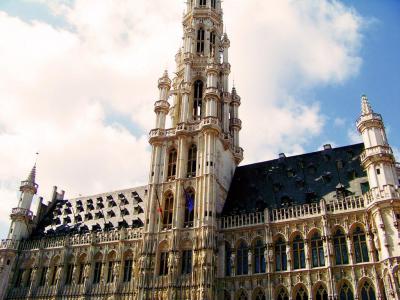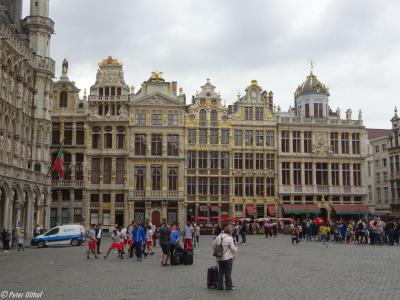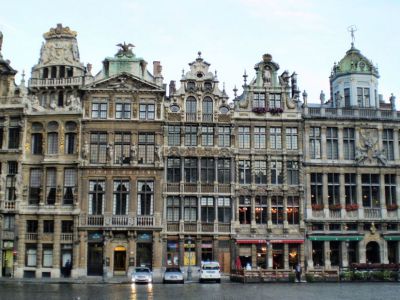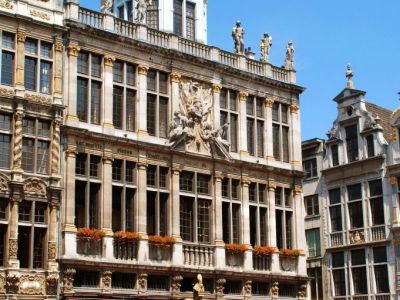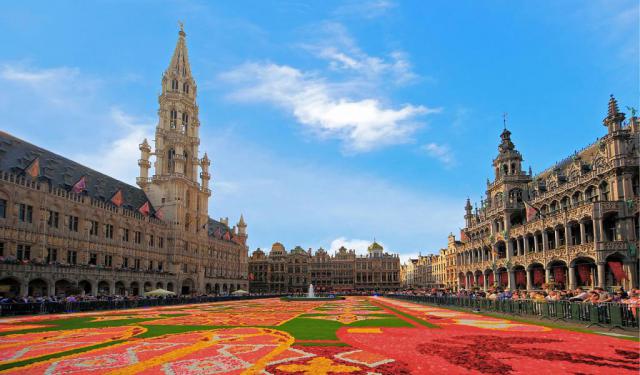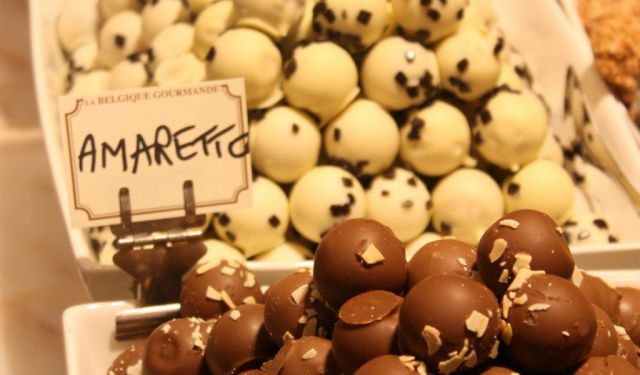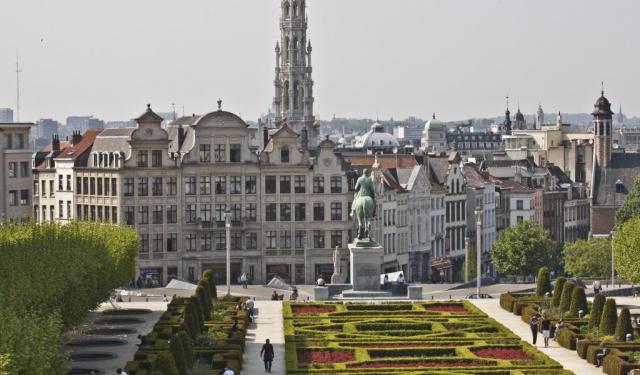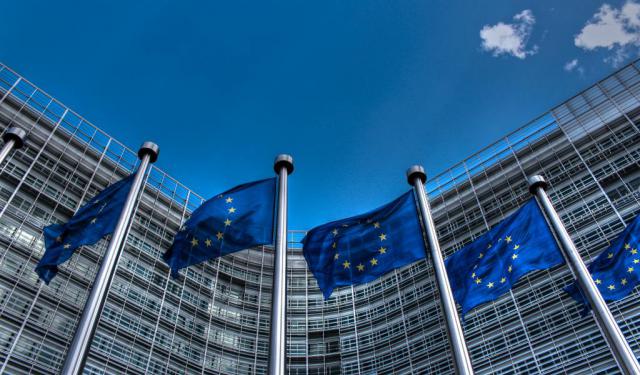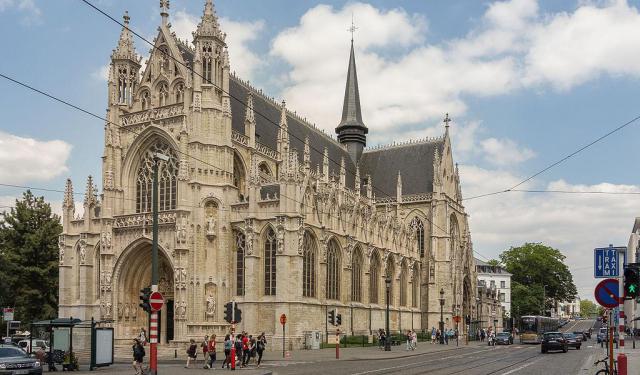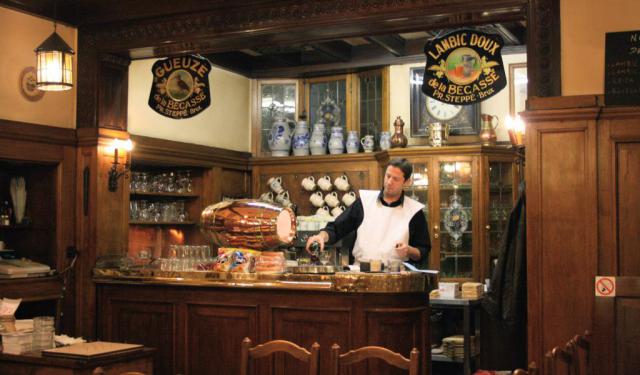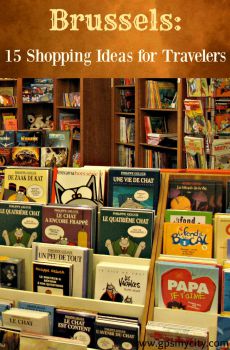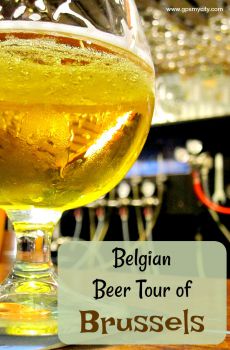Audio Guide: Grand Place Walking Tour (Self Guided), Brussels
The Grand Square in Brussels-steeped in history and overflowing with architectural charm-is the city’s star attraction. Here, the buildings are dressed fancier than most people at a wedding, and every cobblestone whispers, “I’ve seen some stuff.”
Hard to believe, but back in the 11th century, this was just a humble wheat market. Eventually, the area evolved into a civic and commercial hub courtesy of the wealth and power of ambitious local guilds. The mashup of Gothic, Baroque, and Louis XIV styles, resulting from a very determined rebuild following a devastating French bombardment in 1695, earned it a UNESCO World Heritage Site status in 1998.
The square itself is an open-air museum of 17th-century guildhalls, each with unique details and symbolism tied to different trades, and the occasional golden statue. The crown jewel is the Town Hall-a spiky Gothic beauty built between 1401 and 1455, proudly showing off its 96-meter-high tower like a medieval skyscraper.
Directly opposite, we've got the King’s House-which, in reality, never housed a king. These days, it is home to the Brussels City Museum, best known for its extensive, quirky collection of Manneken Pis costumes. (Yes, the little statue has dozens of them.)
Among the other architectural divas, there’s The Pigeon, where Victor Hugo once holed up, and The Golden Boat, glimmering with enough gold to blind you on a sunny day. Then there’s the House of the Dukes of Brabant-not a royal residence, but a really ambitious row of façades with big “look at me” energy.
Keep your eyes peeled for The Golden Tree, The Swan, and The Star buildings. These guildhalls respectively represent the brewers, the butchers, and the innkeepers. The Golden Tree is now the Brewers’ Museum, and The Swan once hosted none other than communism theorists Karl Marx and Friedrich Engels. Clearly, this square has range.
Other guildhalls got even more creative: The Fox for haberdashers, The Cornet with a boat-like backside for the boatmen, The She-Wolf featuring a literal she-wolf, The Bag for the coopers (think barrel-makers, not bag designers), and The Wheelbarrow, proudly sporting a wheelbarrow for the tallow merchants.
And don’t miss The King of Spain-once the bakers’ hangout, now a classic café with a view and a bust of Charles II of Spain keeping watch, probably judging your pastry order.
Whether you're here for the history, the gold-leaf overload, or just trying to one-up your Instagram feed, Grand Square is where Brussels struts its stuff. So, go ahead-snap that photo, sip that beer, and let this square show you why it’s the most extra place in town.
Hard to believe, but back in the 11th century, this was just a humble wheat market. Eventually, the area evolved into a civic and commercial hub courtesy of the wealth and power of ambitious local guilds. The mashup of Gothic, Baroque, and Louis XIV styles, resulting from a very determined rebuild following a devastating French bombardment in 1695, earned it a UNESCO World Heritage Site status in 1998.
The square itself is an open-air museum of 17th-century guildhalls, each with unique details and symbolism tied to different trades, and the occasional golden statue. The crown jewel is the Town Hall-a spiky Gothic beauty built between 1401 and 1455, proudly showing off its 96-meter-high tower like a medieval skyscraper.
Directly opposite, we've got the King’s House-which, in reality, never housed a king. These days, it is home to the Brussels City Museum, best known for its extensive, quirky collection of Manneken Pis costumes. (Yes, the little statue has dozens of them.)
Among the other architectural divas, there’s The Pigeon, where Victor Hugo once holed up, and The Golden Boat, glimmering with enough gold to blind you on a sunny day. Then there’s the House of the Dukes of Brabant-not a royal residence, but a really ambitious row of façades with big “look at me” energy.
Keep your eyes peeled for The Golden Tree, The Swan, and The Star buildings. These guildhalls respectively represent the brewers, the butchers, and the innkeepers. The Golden Tree is now the Brewers’ Museum, and The Swan once hosted none other than communism theorists Karl Marx and Friedrich Engels. Clearly, this square has range.
Other guildhalls got even more creative: The Fox for haberdashers, The Cornet with a boat-like backside for the boatmen, The She-Wolf featuring a literal she-wolf, The Bag for the coopers (think barrel-makers, not bag designers), and The Wheelbarrow, proudly sporting a wheelbarrow for the tallow merchants.
And don’t miss The King of Spain-once the bakers’ hangout, now a classic café with a view and a bust of Charles II of Spain keeping watch, probably judging your pastry order.
Whether you're here for the history, the gold-leaf overload, or just trying to one-up your Instagram feed, Grand Square is where Brussels struts its stuff. So, go ahead-snap that photo, sip that beer, and let this square show you why it’s the most extra place in town.
How it works: Download the app "GPSmyCity: Walks in 1K+ Cities" from Apple App Store or Google Play Store to your mobile phone or tablet. The app turns your mobile device into a personal tour guide and its built-in GPS navigation functions guide you from one tour stop to next. The app works offline, so no data plan is needed when traveling abroad.
Grand Place Walking Tour Map
Guide Name: Grand Place Walking Tour
Guide Location: Belgium » Brussels (See other walking tours in Brussels)
Guide Type: Self-guided Walking Tour (Sightseeing)
# of Attractions: 9
Tour Duration: 1 Hour(s)
Travel Distance: 0.3 Km or 0.2 Miles
Author: audrey
Sight(s) Featured in This Guide:
Guide Location: Belgium » Brussels (See other walking tours in Brussels)
Guide Type: Self-guided Walking Tour (Sightseeing)
# of Attractions: 9
Tour Duration: 1 Hour(s)
Travel Distance: 0.3 Km or 0.2 Miles
Author: audrey
Sight(s) Featured in This Guide:
- Grand Place (Grand Square)
- King's House / Brussels City Museum
- Le Pigeon (The Pigeon) / La Chaloupe d'Or (The Golden Boat)
- House of the Dukes of Brabant
- L'Arbre d'Or (The Golden Tree), Le Cygne (The Swan), and L'Étoile (The Star)
- Hotel de Ville (Town Hall)
- Le Renard (The Fox)/Le Cornet (The Cornet)
- La Louve (The She-Wolf) / Le Sac (The Bag) / La Brouette (The Wheelbarrow)
- Le Roy d'Espagne (The King of Spain)
1) Grand Place (Grand Square) (must see)
Grand Square-Brussels’ pride and joy-is the biggest show-off move of the Belgian capital. Some say it's the most beautiful square in Europe. Others say the world. Either way, it’s hard to argue when you’re standing there, dwarfed by a 15th-century Gothic Town Hall that looks like it got dressed for the Met Gala... and the neo-Gothic King's House-also charmingly called the Bread House (because apparently even royal buildings get carb cravings).
This cobblestoned stunner has been in the spotlight since the 11th century. Back then, it was a humble marketplace. A few hundred years later, it had a front-row seat to history-picture Inquisition bonfires and a couple of unfortunate noble executions (some sort of “light afternoon entertainment” for the medieval crowd)...
As Brussels bloomed, so did the square’s bling. Surrounding it are guildhalls that practically scream, “We have money and good taste!” Each one was built by a different trade-from haberdashers to bakers to brewers-and while the jobs have changed, the beauty hasn’t. Take Number 10, for example-once a brewers’ headquarters, now home to the Brewers Museum, so yes, beer still lives there. Circle of life.
Now, not everything has been smooth sailing here. In 1695, the French decided Brussels needed a “makeover.” So they bombarded the square for 36 hours straight. Miraculously, several buildings were rebuilt after that even better. Like Number 3, once run by tallow merchants, and Number 5, home of the archers’ guild, proudly rocking a phoenix on its façade-a little "burn me once" statement piece.
Today, in addition to being a history lesson with a stunning backdrop, the Grand Square is a vibe. Alleyways nearby are filled with centuries-old bars serving the holy trinity: Belgian beer, chocolate, and gossip. Butchers Street is your go-to for mussels and souvenirs and maybe some stretchy pants.
And if you time it right, you’ll catch the square in full party mode. There’s the biennial Flower Carpet-a psychedelic begonia explosion, the medieval cosplay of Ommegang, Christmas lights that would make the North Pole jealous, and concerts that echo through time.
Tip:
Visit in daylight to admire every gold-leafed flourish, and come back after dark for the light show. Around 10:20 PM, this square doesn’t just sparkle-it sings.
This cobblestoned stunner has been in the spotlight since the 11th century. Back then, it was a humble marketplace. A few hundred years later, it had a front-row seat to history-picture Inquisition bonfires and a couple of unfortunate noble executions (some sort of “light afternoon entertainment” for the medieval crowd)...
As Brussels bloomed, so did the square’s bling. Surrounding it are guildhalls that practically scream, “We have money and good taste!” Each one was built by a different trade-from haberdashers to bakers to brewers-and while the jobs have changed, the beauty hasn’t. Take Number 10, for example-once a brewers’ headquarters, now home to the Brewers Museum, so yes, beer still lives there. Circle of life.
Now, not everything has been smooth sailing here. In 1695, the French decided Brussels needed a “makeover.” So they bombarded the square for 36 hours straight. Miraculously, several buildings were rebuilt after that even better. Like Number 3, once run by tallow merchants, and Number 5, home of the archers’ guild, proudly rocking a phoenix on its façade-a little "burn me once" statement piece.
Today, in addition to being a history lesson with a stunning backdrop, the Grand Square is a vibe. Alleyways nearby are filled with centuries-old bars serving the holy trinity: Belgian beer, chocolate, and gossip. Butchers Street is your go-to for mussels and souvenirs and maybe some stretchy pants.
And if you time it right, you’ll catch the square in full party mode. There’s the biennial Flower Carpet-a psychedelic begonia explosion, the medieval cosplay of Ommegang, Christmas lights that would make the North Pole jealous, and concerts that echo through time.
Tip:
Visit in daylight to admire every gold-leafed flourish, and come back after dark for the light show. Around 10:20 PM, this square doesn’t just sparkle-it sings.
2) King's House / Brussels City Museum
The King's House, also known as the Bread House or Bread Hall in Dutch, has a long, layered history. "Why bread?" you ask. Because before it became all regal and museum-y, this spot was literally the place to get your carbs. Back in the 12th century, it was a humble, wooden bread market. But by the 15th century, it had a glow-up into a stone building, moonlighting as the admin center for the Duke of Brabant.
At some point in history, the Duke leveled up and became King of Spain, and so The Bread House got an upgrade in name too: King’s House. Fancy, huh?
Then, in the 16th century, along came Emperor Charles V, who decided the building needed a bit of Gothic drama. So he added a few pointy arches, some flair, and got himself a serious statement piece.
Unfortunately, the French dropped by in 1695… with cannons. The building took a hit and went through various touch-ups over the years, including a neoclassical facelift in 1767. But it wasn't until Victor Jamaer came strutting in between 1874 and 1896 that the King’s House got its full neo-Gothic glam back. Jamaer put in towers, galleries, statues galore, and even a neo-Renaissance rear wing-because why not?
Since 1887, this eye candy of a building has housed the Brussels City Museum. It’s basically a treasure chest of over 7,000 objects: town hall sculptures, old city maps, silverware, tapestries, and some serious art featuring the likes of Bruegel the Elder and Rubens.
Now, for the crowd favorite: head to the top floor and meet the Manneken Pis. Yep, the original cheeky little statue himself, along with a sample of his international fashion collection. Most of his wardrobe lives in the Garderobe MannekenPis, just a short walk away-because yes, he has his own museum.
Oh, and if you're planning a visit? The museum is open daily-except Mondays-from 10 a.m. to 5 p.m.
Tip:
It’s free on the first Sunday of each month.
Want the full experience without fumbling through French? Grab the audio guide. Your ears will thank you.
At some point in history, the Duke leveled up and became King of Spain, and so The Bread House got an upgrade in name too: King’s House. Fancy, huh?
Then, in the 16th century, along came Emperor Charles V, who decided the building needed a bit of Gothic drama. So he added a few pointy arches, some flair, and got himself a serious statement piece.
Unfortunately, the French dropped by in 1695… with cannons. The building took a hit and went through various touch-ups over the years, including a neoclassical facelift in 1767. But it wasn't until Victor Jamaer came strutting in between 1874 and 1896 that the King’s House got its full neo-Gothic glam back. Jamaer put in towers, galleries, statues galore, and even a neo-Renaissance rear wing-because why not?
Since 1887, this eye candy of a building has housed the Brussels City Museum. It’s basically a treasure chest of over 7,000 objects: town hall sculptures, old city maps, silverware, tapestries, and some serious art featuring the likes of Bruegel the Elder and Rubens.
Now, for the crowd favorite: head to the top floor and meet the Manneken Pis. Yep, the original cheeky little statue himself, along with a sample of his international fashion collection. Most of his wardrobe lives in the Garderobe MannekenPis, just a short walk away-because yes, he has his own museum.
Oh, and if you're planning a visit? The museum is open daily-except Mondays-from 10 a.m. to 5 p.m.
Tip:
It’s free on the first Sunday of each month.
Want the full experience without fumbling through French? Grab the audio guide. Your ears will thank you.
3) Le Pigeon (The Pigeon) / La Chaloupe d'Or (The Golden Boat)
The Pigeon-one of the many fancy guild houses overlooking Brussels’ star-studded main square- might not be the flashiest of the bunch. It's got no gold-drenched unicorns or ships for balconies, but it’s got charm. And brains. And a bit of literary spice.
Originally the clubhouse for the city’s painters, the building took its name from a modest little sign featuring-you guessed it-a pigeon. But don’t let the bird fool you. This place once hosted none other than Victor Hugo himself. Yes, that very same Victor Hugo who wrote Les Misérables and probably made a lot of French teenagers cry in literature class.
In 1852, while exiled from France for not exactly being besties with Napoleon III, Hugo moved in upstairs here. From that very perch, he admired the Grand Square and called it “the most beautiful square in the world.” Honestly, hard to disagree-especially with that kind of view and no rent to pay.
But Hugo wasn’t just swooning over Baroque rooftops. Between gazing lovingly at the architecture, he found time to absolutely roast Belgian politics-calling the monarchy a “farce” and the government “absurd.” All this while sipping coffee and writing from a room above a bird sign. Exile’s never looked so cozy...
Today, you can’t go inside The Pigeon-it’s not a museum-but you can ogle its elegant Baroque façade, sculpted details, and glittering touches, all rebuilt after the French bombed Brussels in 1695. (Awkward, considering Hugo’s later residence.)
Standing outside, keep your eyes peeled for the sculpted pigeon perched above the door-an architectural Easter egg if there ever was one-and a plaque honoring Hugo’s poetic crash pad.
Now glide on over to The Golden Boat-which, despite the name, is more baroque than buoyant. Once the headquarters of the tailors’ guild, this post-bombardment rebuild from 1697 was stitched back together and topped with Saint Homobonus, the patron saint of tailors, looking very pleased with the real estate.
And the best part? You can pop in for a beer and a bite downstairs-because this golden ship now sails as a Belgian café-restaurant. Saintly skyline, savory snacks. It's like eating history, with extra sauce...
Tip:
Swing by after dark. The whole square lights up like a scene from a romantic period drama, and these two are worth a lingering look as a gilded footnote in a very stylish chapter of European history.
Originally the clubhouse for the city’s painters, the building took its name from a modest little sign featuring-you guessed it-a pigeon. But don’t let the bird fool you. This place once hosted none other than Victor Hugo himself. Yes, that very same Victor Hugo who wrote Les Misérables and probably made a lot of French teenagers cry in literature class.
In 1852, while exiled from France for not exactly being besties with Napoleon III, Hugo moved in upstairs here. From that very perch, he admired the Grand Square and called it “the most beautiful square in the world.” Honestly, hard to disagree-especially with that kind of view and no rent to pay.
But Hugo wasn’t just swooning over Baroque rooftops. Between gazing lovingly at the architecture, he found time to absolutely roast Belgian politics-calling the monarchy a “farce” and the government “absurd.” All this while sipping coffee and writing from a room above a bird sign. Exile’s never looked so cozy...
Today, you can’t go inside The Pigeon-it’s not a museum-but you can ogle its elegant Baroque façade, sculpted details, and glittering touches, all rebuilt after the French bombed Brussels in 1695. (Awkward, considering Hugo’s later residence.)
Standing outside, keep your eyes peeled for the sculpted pigeon perched above the door-an architectural Easter egg if there ever was one-and a plaque honoring Hugo’s poetic crash pad.
Now glide on over to The Golden Boat-which, despite the name, is more baroque than buoyant. Once the headquarters of the tailors’ guild, this post-bombardment rebuild from 1697 was stitched back together and topped with Saint Homobonus, the patron saint of tailors, looking very pleased with the real estate.
And the best part? You can pop in for a beer and a bite downstairs-because this golden ship now sails as a Belgian café-restaurant. Saintly skyline, savory snacks. It's like eating history, with extra sauce...
Tip:
Swing by after dark. The whole square lights up like a scene from a romantic period drama, and these two are worth a lingering look as a gilded footnote in a very stylish chapter of European history.
4) House of the Dukes of Brabant
Now, don’t be confused by the fancy name-The House of the Dukes of Brabant is not one big royal residence. It’s actually seven guildhalls in architectural disguise, each with a name straight out of a medieval fantasy novel: The Fame, The Hermitage, The Fortune, The Windmill, The Tin Pot, The Hill, and The Purse. Sounds like a band of eccentric nobles or the titles of long-lost pubs, but these were the proud homes of Brussels’ hard-working guilds-carpet makers, millers, cartwrights, tanners... the dream team of 17th-century city life.
Now, if you look up, you will see 19 stone faces watching you from the building’s façade. Those are the busts of the actual Dukes of Brabant, the folks for whom this building ensemble is named. This decorative feature-part architectural flex, part history lesson carved in stone-pays homage to the historical Duchy of Brabant, once a significant feudal territory in the Low Countries.
This stylish stretch of guildhalls was rebuilt after the French dropped by uninvited-with cannons-in 1695. The Grand Square got pummeled, but Brussels bounced back fast. In less than five years, the square was reborn, dressed to impress in a unified Baroque style.
While you can’t go inside these buildings-they’re mostly private now-the façade is truly where their magic lives. It’s a visual feast of gold leaf, symmetry, and proud guild swagger.
So when you’re standing there in the middle of the Grand Square, cappuccino in hand, don’t just snap a selfie and move on. Give a respectful nod to this architectural overachiever and its seven alter egos. You’re looking at history-gilded, bust-lined, and just a little bit dramatic.
And yes, the Grand Square is a UNESCO World Heritage site. But really, one look at this building and you’ll say, “Well… obviously.”
Now, if you look up, you will see 19 stone faces watching you from the building’s façade. Those are the busts of the actual Dukes of Brabant, the folks for whom this building ensemble is named. This decorative feature-part architectural flex, part history lesson carved in stone-pays homage to the historical Duchy of Brabant, once a significant feudal territory in the Low Countries.
This stylish stretch of guildhalls was rebuilt after the French dropped by uninvited-with cannons-in 1695. The Grand Square got pummeled, but Brussels bounced back fast. In less than five years, the square was reborn, dressed to impress in a unified Baroque style.
While you can’t go inside these buildings-they’re mostly private now-the façade is truly where their magic lives. It’s a visual feast of gold leaf, symmetry, and proud guild swagger.
So when you’re standing there in the middle of the Grand Square, cappuccino in hand, don’t just snap a selfie and move on. Give a respectful nod to this architectural overachiever and its seven alter egos. You’re looking at history-gilded, bust-lined, and just a little bit dramatic.
And yes, the Grand Square is a UNESCO World Heritage site. But really, one look at this building and you’ll say, “Well… obviously.”
5) L'Arbre d'Or (The Golden Tree), Le Cygne (The Swan), and L'Étoile (The Star)
Now, let's zoom in on three other show-stealing guild houses in Grand Square: The Golden Tree, The Swan, and The Star-each with its own backstory, flair, and photo op.
First up: The Golden Tree, at Number 10. Once the proud headquarters of the Brewers' Guild, this place practically oozes hops and heritage. Rebuilt after the French “cannon fireworks” in 1695, its Baroque façade is dripping with gold, grain motifs, and a dramatic statue of Prince Charles of Lorraine (the former governor of the Austrian Netherlands) on horseback. Today, it’s home to the Belgian Brewers Museum-a small but mighty exhibit where you can geek out over brewing tools and end with (what else) a beer tasting. Bonus fact: It's still owned by a professional guild, which makes it the overachiever of the square.
Next door, at Number 9, we’ve got The Swan-elegant, mysterious, and with a touch of revolutionary gossip. Built in 1698 and once tied to the butchers' guild (yes, those are ox heads and cleavers on the facade), The Swan pivoted hard in the 1840s to become a political hangout. Karl Marx and Friedrich Engels met here, likely arguing over pints, and Brussels is where they penned The Communist Manifesto. The building later gave rise to the Belgian Workers' Party. Today, it’s a swanky restaurant with chandeliers, foie gras, and just a pinch of proletarian past.
And now, rounding things off with charm and compactness: The Star. Tucked into the corner where Charles Buls Street kisses the Grand Square, this petite beauty stands where a medieval gate once stood. Its most famous feature is the statue of Everard 't Serclaes, a local hero celebrated for liberating Brussels in the 14th century. Reclining under an arcade like a Belgian version of a chill Greek god, he's your go-to for good luck. Rub his golden arm or leg, and you might just find love-or at least an excuse to come back.
So whether you're sipping history, dining with revolution, or rubbing bronze for romance, these three iconic guild houses prove the Grand Square isn’t just a square-it’s a stage.
First up: The Golden Tree, at Number 10. Once the proud headquarters of the Brewers' Guild, this place practically oozes hops and heritage. Rebuilt after the French “cannon fireworks” in 1695, its Baroque façade is dripping with gold, grain motifs, and a dramatic statue of Prince Charles of Lorraine (the former governor of the Austrian Netherlands) on horseback. Today, it’s home to the Belgian Brewers Museum-a small but mighty exhibit where you can geek out over brewing tools and end with (what else) a beer tasting. Bonus fact: It's still owned by a professional guild, which makes it the overachiever of the square.
Next door, at Number 9, we’ve got The Swan-elegant, mysterious, and with a touch of revolutionary gossip. Built in 1698 and once tied to the butchers' guild (yes, those are ox heads and cleavers on the facade), The Swan pivoted hard in the 1840s to become a political hangout. Karl Marx and Friedrich Engels met here, likely arguing over pints, and Brussels is where they penned The Communist Manifesto. The building later gave rise to the Belgian Workers' Party. Today, it’s a swanky restaurant with chandeliers, foie gras, and just a pinch of proletarian past.
And now, rounding things off with charm and compactness: The Star. Tucked into the corner where Charles Buls Street kisses the Grand Square, this petite beauty stands where a medieval gate once stood. Its most famous feature is the statue of Everard 't Serclaes, a local hero celebrated for liberating Brussels in the 14th century. Reclining under an arcade like a Belgian version of a chill Greek god, he's your go-to for good luck. Rub his golden arm or leg, and you might just find love-or at least an excuse to come back.
So whether you're sipping history, dining with revolution, or rubbing bronze for romance, these three iconic guild houses prove the Grand Square isn’t just a square-it’s a stage.
6) Hotel de Ville (Town Hall) (must see)
The Brussels Town Hall-part municipal headquarters, part medieval masterpiece, and all-around showoff of the Grand Square. Built between 1401 and 1455, this beauty is the only medieval building still standing in the square. Rich in Brabantine Gothic flair, it was declared a protected monument in 1936 and added to UNESCO’s World Heritage Site list in 1998.
Despite its regal look, the building’s had its fair share of drama. In 1695, during the Nine Years' War, the French heavily bombarded the city. The Town Hall took a hit: fire gutted the interior, torched the archives, and turned priceless artworks into ashes. And yet, like a true diva, it survived.
Its present-day form-a tidy quadrilateral wrapped around a central courtyard-dates from the 18th century, when two extra wings were slapped on the back. Then came the 19th century, when restorers went full "Gothic revival" mode and added nearly 300 statues, gargoyles, and fancy flourishes-because subtlety is not the style for this kind of property. Each ornament nods to Brussels’ proud guild traditions and colorful past.
Speaking of drama, notice that the tower isn’t centered? Legend says that the architect, Jan van Ruysbroek, was so distraught over the lopsided design that he threw himself off the tower. Dark... But let’s be real-it was probably just a classic case of medieval planning chaos.
Crowning the 96-meter tower is a golden spire topped with Saint Michael giving a devil the boot. The current statue is a 1990s replica, but the original goes back to 1455. Inside, it’s all chandeliers, frescoes, and enough historic rooms to make your head spin. Check out the Gothic Room, the Prince’s Gallery, the Mayor’s Cabinet, and the crown jewel-the States of Brabant Room, with a ceiling that deserves its own fan club.
Tip:
You can visit the inside, but only with a guided tour-around 45 minutes long and available in French, English, Dutch, or Spanish. Spots are limited and sell out fast, so grab your ticket early in the day. Tours run on Mondays, Wednesdays, Fridays, Saturdays, and Sundays. Just don’t show up on January 1, May 1, November 1 or 11, or December 25-because even grand old Town Halls need a day off.
Despite its regal look, the building’s had its fair share of drama. In 1695, during the Nine Years' War, the French heavily bombarded the city. The Town Hall took a hit: fire gutted the interior, torched the archives, and turned priceless artworks into ashes. And yet, like a true diva, it survived.
Its present-day form-a tidy quadrilateral wrapped around a central courtyard-dates from the 18th century, when two extra wings were slapped on the back. Then came the 19th century, when restorers went full "Gothic revival" mode and added nearly 300 statues, gargoyles, and fancy flourishes-because subtlety is not the style for this kind of property. Each ornament nods to Brussels’ proud guild traditions and colorful past.
Speaking of drama, notice that the tower isn’t centered? Legend says that the architect, Jan van Ruysbroek, was so distraught over the lopsided design that he threw himself off the tower. Dark... But let’s be real-it was probably just a classic case of medieval planning chaos.
Crowning the 96-meter tower is a golden spire topped with Saint Michael giving a devil the boot. The current statue is a 1990s replica, but the original goes back to 1455. Inside, it’s all chandeliers, frescoes, and enough historic rooms to make your head spin. Check out the Gothic Room, the Prince’s Gallery, the Mayor’s Cabinet, and the crown jewel-the States of Brabant Room, with a ceiling that deserves its own fan club.
Tip:
You can visit the inside, but only with a guided tour-around 45 minutes long and available in French, English, Dutch, or Spanish. Spots are limited and sell out fast, so grab your ticket early in the day. Tours run on Mondays, Wednesdays, Fridays, Saturdays, and Sundays. Just don’t show up on January 1, May 1, November 1 or 11, or December 25-because even grand old Town Halls need a day off.
7) Le Renard (The Fox)/Le Cornet (The Cornet)
Now check out another two show-offs on the Grand Place stage-The Fox and The Cornet. By far not just average buildings, these are 17th-century drama queens carved in stone, telling tales of trades, triumphs, and, yes, a bit of tasteful self-promotion.
First up: The Fox. This was the stylish headquarters of Brussels’ haberdashers-dealers in sewing trinkets and accessories. Think of them as the 15th-century fashion influencers, minus the ring light. Rebuilt in 1699 after the French sort of “redecorated” Brussels with cannonballs, its façade is now a masterclass in symbolism. Above the doorway is a slender fox-because branding matters. Below that: Bas-reliefs showing the haberdashers doing their thing, plus four allegorical figures representing Africa, America, Asia, and Europe. Right in the middle is a statue of Lady Justice, because even sewing supplies deserve ethical trading practices. And topping it all off, Saint Nicholas, the patron saint of merchants, watching over it all like a spiritual CEO.
Next door: The Cornet. Built for the boatmen’s guild, this one ditched subtlety and went full-on ship mode. Its gable looks like the back end of a fancy vessel-anchors, oars, ropes, and even sculpted winds doing their best Beyoncé hair-blowing impressions. Originally constructed between 1641 and 1645 and rebuilt in 1697, it is basically a ship frozen mid-sail, cruising through the cobblestones of Brussels. Medallions of Charles II of Spain and rugged sailor figures complete the look. If buildings could wear cologne, The Cornet would smell like salt air and bravado.
Together, The Fox and The Cornet are more than just fancy façades but Brussels' own stone-carved profiles: all about hustle, heritage, and a touch of theatrical flair.
Tip:
You can’t go inside these beauties, but believe it-the outside is doing all the heavy lifting. Come by day to admire the detailed carving work, or swing by at night for that moody, shadow-drenched lighting that turns stone into sculpture.
First up: The Fox. This was the stylish headquarters of Brussels’ haberdashers-dealers in sewing trinkets and accessories. Think of them as the 15th-century fashion influencers, minus the ring light. Rebuilt in 1699 after the French sort of “redecorated” Brussels with cannonballs, its façade is now a masterclass in symbolism. Above the doorway is a slender fox-because branding matters. Below that: Bas-reliefs showing the haberdashers doing their thing, plus four allegorical figures representing Africa, America, Asia, and Europe. Right in the middle is a statue of Lady Justice, because even sewing supplies deserve ethical trading practices. And topping it all off, Saint Nicholas, the patron saint of merchants, watching over it all like a spiritual CEO.
Next door: The Cornet. Built for the boatmen’s guild, this one ditched subtlety and went full-on ship mode. Its gable looks like the back end of a fancy vessel-anchors, oars, ropes, and even sculpted winds doing their best Beyoncé hair-blowing impressions. Originally constructed between 1641 and 1645 and rebuilt in 1697, it is basically a ship frozen mid-sail, cruising through the cobblestones of Brussels. Medallions of Charles II of Spain and rugged sailor figures complete the look. If buildings could wear cologne, The Cornet would smell like salt air and bravado.
Together, The Fox and The Cornet are more than just fancy façades but Brussels' own stone-carved profiles: all about hustle, heritage, and a touch of theatrical flair.
Tip:
You can’t go inside these beauties, but believe it-the outside is doing all the heavy lifting. Come by day to admire the detailed carving work, or swing by at night for that moody, shadow-drenched lighting that turns stone into sculpture.
8) La Louve (The She-Wolf) / Le Sac (The Bag) / La Brouette (The Wheelbarrow)
Every building in Brussels' Grand Square has enough flair for a soap opera. Among this theatrical cast of ornate façades, three characters steal the spotlight, namely: The She-Wolf, The Bag, and The Wheelbarrow. So, buckle up-it's guild drama, 17th-century style...
Coming in hot at Number 5, The She-Wolf building once belonged to the Oath of Archers-think medieval neighborhood watch, but with better aim. Rebuilt after Brussels got a not-so-friendly visit from the French in 1695, its new look features a phoenix rising from the ashes (very on-brand for post-bombardment Brussels). Peek up, and you’ll see Apollo mid-drama slaying Python, and four statues below repping Team Truth, Team Lies, Peace, and Discord. It’s basically a mythological group chat carved in stone.
Next door at Number 4 is The Bag, the house that carpenters built-literally. Originally crafted in 1644 and given a Baroque restyle in 1697, the façade flexes with chisels, saws, and all the trade bling. Above the door is a guy pulling something from a bag-very meta. Today, it’s a café where you can sip your coffee under a roof built by the OG toolbox crew.
And now for a double bill at Numbers 2 and 3: The Wheelbarrow, the headquarters of the greasers. No, not the leather-jacket kind-these folks sold butter, eggs, poultry, the whole brunch kit. The golden wheelbarrows above the door say it all. Reborn in 1697 and crowned in 1912 with a statue of Saint Giles (patron saint of greasy things), this place now houses a café where you can chow down like a butter baron.
In essence, these three buildings are true characters, survivors, and storytellers. So, whether you're an architecture nerd, a history buff, or just here for a waffle with a view, the Grand Square’s guild houses are ready for their close-up. Go ahead, wander in. The past has excellent curb appeal.
Coming in hot at Number 5, The She-Wolf building once belonged to the Oath of Archers-think medieval neighborhood watch, but with better aim. Rebuilt after Brussels got a not-so-friendly visit from the French in 1695, its new look features a phoenix rising from the ashes (very on-brand for post-bombardment Brussels). Peek up, and you’ll see Apollo mid-drama slaying Python, and four statues below repping Team Truth, Team Lies, Peace, and Discord. It’s basically a mythological group chat carved in stone.
Next door at Number 4 is The Bag, the house that carpenters built-literally. Originally crafted in 1644 and given a Baroque restyle in 1697, the façade flexes with chisels, saws, and all the trade bling. Above the door is a guy pulling something from a bag-very meta. Today, it’s a café where you can sip your coffee under a roof built by the OG toolbox crew.
And now for a double bill at Numbers 2 and 3: The Wheelbarrow, the headquarters of the greasers. No, not the leather-jacket kind-these folks sold butter, eggs, poultry, the whole brunch kit. The golden wheelbarrows above the door say it all. Reborn in 1697 and crowned in 1912 with a statue of Saint Giles (patron saint of greasy things), this place now houses a café where you can chow down like a butter baron.
In essence, these three buildings are true characters, survivors, and storytellers. So, whether you're an architecture nerd, a history buff, or just here for a waffle with a view, the Grand Square’s guild houses are ready for their close-up. Go ahead, wander in. The past has excellent curb appeal.
9) Le Roy d'Espagne (The King of Spain)
Now, The King of Spain... a historic brasserie parked proudly at Number 1 Grand Square in Brussels. Here, Belgian beer meets Baroque drama, and croissants come with a side of centuries-old gossip.
Built in 1697 as the official hangout of the bakers’ guild, this building replaced the former residence of the noble Serhuyghs family. And if you’re wondering why the royal name, just look up-King Charles II of Spain is keeping watch from the second floor, a nod to the days when Brussels was under Spanish rule and wigs were bigger than your head.
Checking out the façade, you can't help noticing Roman emperors like Marcus Aurelius and Trajan chilling in medallion form, rooftop statues that turn baking into a Marvel movie (with symbols like wind, fire, and foresight), and a golden weathervane shaped like Fame herself. Also, don’t miss the bust of Saint Aubert-the patron saint of bakers-glinting above the entrance in bronze and gold, keeping an eye on your baguette choices.
And, of course, no grand European building can escape drama. The King of Spain took a beating during the French Revolution but got a facelift in 1902 thanks to the then city mayor and his "Make Grand Square Gorgeous Again" campaign. It briefly dabbled in being a hardware store-because why not-but thankfully, in 1952, it embraced its destiny as a brasserie once again.
Today, the building is back in full culinary glory, serving up classic Belgian fare with local ingredients and a beer list that reads like a novel-over 43 brews, 10 of them on tap. Whether you're inside soaking up the 19th-century street vibe or lounging outside on the terrace with front-row views of the Grand Square, you’re in for a treat.
Open daily from 8 a.m. to 1 a.m., this place is where you start your day, end your night, or accidentally stay for both. If you're a history buff, foodie, beer hunter, or just people-watching champion, congratulations!-You’ve found your royal seat.
Built in 1697 as the official hangout of the bakers’ guild, this building replaced the former residence of the noble Serhuyghs family. And if you’re wondering why the royal name, just look up-King Charles II of Spain is keeping watch from the second floor, a nod to the days when Brussels was under Spanish rule and wigs were bigger than your head.
Checking out the façade, you can't help noticing Roman emperors like Marcus Aurelius and Trajan chilling in medallion form, rooftop statues that turn baking into a Marvel movie (with symbols like wind, fire, and foresight), and a golden weathervane shaped like Fame herself. Also, don’t miss the bust of Saint Aubert-the patron saint of bakers-glinting above the entrance in bronze and gold, keeping an eye on your baguette choices.
And, of course, no grand European building can escape drama. The King of Spain took a beating during the French Revolution but got a facelift in 1902 thanks to the then city mayor and his "Make Grand Square Gorgeous Again" campaign. It briefly dabbled in being a hardware store-because why not-but thankfully, in 1952, it embraced its destiny as a brasserie once again.
Today, the building is back in full culinary glory, serving up classic Belgian fare with local ingredients and a beer list that reads like a novel-over 43 brews, 10 of them on tap. Whether you're inside soaking up the 19th-century street vibe or lounging outside on the terrace with front-row views of the Grand Square, you’re in for a treat.
Open daily from 8 a.m. to 1 a.m., this place is where you start your day, end your night, or accidentally stay for both. If you're a history buff, foodie, beer hunter, or just people-watching champion, congratulations!-You’ve found your royal seat.
Walking Tours in Brussels, Belgium
Create Your Own Walk in Brussels
Creating your own self-guided walk in Brussels is easy and fun. Choose the city attractions that you want to see and a walk route map will be created just for you. You can even set your hotel as the start point of the walk.
Brussels Introduction Walking Tour
Nowadays a major center for international politics, the capital of Belgium, Brussels, is often referred to as the "Crossroads of Europe". Indeed, nestled at the heart of the continent, this city has a history closely linked to that of Western Europe. Repeatedly changing hands between various duchies, empires, republics, and kingdoms, it has evolved from a small rural settlement to an... view more
Tour Duration: 2 Hour(s)
Travel Distance: 3.6 Km or 2.2 Miles
Tour Duration: 2 Hour(s)
Travel Distance: 3.6 Km or 2.2 Miles
Chocolate Tour in Brussels
Belgium is considered one of, if not the, best producer of chocolate in the world. The country's capital, Brussels abounds in opportunities to taste more than 2,000 different varieties of this delectable treat. There is a plethora of chocolate shops in the city which offer chocolates of all imaginable shapes, sizes and colors.
Planète Chocolat’s chocolate-making demonstration make a... view more
Tour Duration: 1 Hour(s)
Travel Distance: 1.5 Km or 0.9 Miles
Planète Chocolat’s chocolate-making demonstration make a... view more
Tour Duration: 1 Hour(s)
Travel Distance: 1.5 Km or 0.9 Miles
Mont Des Arts Cultural Walk
Mont des Arts, meaning "hill of the arts", is one of the most important cultural sites in Brussels. A classic among the city’s vantage points, it offers a fine city garden and restored showcase of architecture, in addition to several great museums.
Start your journey by traveling towards the old part of the city, where you’ll find the BOZAR Centre for Fine Arts, greatly admired... view more
Tour Duration: 1 Hour(s)
Travel Distance: 1.0 Km or 0.6 Miles
Start your journey by traveling towards the old part of the city, where you’ll find the BOZAR Centre for Fine Arts, greatly admired... view more
Tour Duration: 1 Hour(s)
Travel Distance: 1.0 Km or 0.6 Miles
The European Quarter Walking Tour
Along with Luxembourg and Strasbourg, Brussels is one of the European Union’s de facto capitals. The office blocks of the European Quarter are mainly concentrated along and between two wide boulevards – rue de la Loi and rue Belliard – which Léopold II built to connect his Parc du Cinquantenaire with the city center.
Begin your exploration with the EU’s most symbolic construction, the... view more
Tour Duration: 1 Hour(s)
Travel Distance: 1.3 Km or 0.8 Miles
Begin your exploration with the EU’s most symbolic construction, the... view more
Tour Duration: 1 Hour(s)
Travel Distance: 1.3 Km or 0.8 Miles
Brussels Historical Churches Walking Tour
As well as being Belgium’s political and cultural capital, Brussels is the spiritual home of its most significant churches. Historically, the city has been predominantly Roman Catholic, especially since the expulsion of Protestants in the 16th century. The pre-eminent Catholic temple here, located just a couple of minutes from the Grand-Place, is the Brabantine Gothic Cathedral of St. Michael... view more
Tour Duration: 2 Hour(s)
Travel Distance: 4.6 Km or 2.9 Miles
Tour Duration: 2 Hour(s)
Travel Distance: 4.6 Km or 2.9 Miles
Brussels Beer Tour
Belgians are not very prone to boasting, except with things such as chocolate, fries and, evidently, beer. They treat beer the way the French treat wine: for the makers, it's a prized art; for the drinkers, it is something to be savored and discussed. They say that, on average, Belgians drink 150 liters of beer per year per person, and one would often see them sipping it from early in the... view more
Tour Duration: 1 Hour(s)
Travel Distance: 2.1 Km or 1.3 Miles
Tour Duration: 1 Hour(s)
Travel Distance: 2.1 Km or 1.3 Miles
Useful Travel Guides for Planning Your Trip
What to Buy in Brussels: 14 Ideas for Travelers
It's no secret that Brussels is not all about JCVD muscles and EU headquarters. Small country as such, Belgium abounds in signature items, such as beer, chocolates and... the peeing boy. All of these have made prime Belgian souvenirs for years. Now you can explore the Brussels gift scene in...
Belgian Beer Tour of Brussels
Belgium is world-renowned for its beers and Brussels is the best city to sample the huge variety of flavors. We'll show you the best places to buy them and to drink them. We'll even show you a family brewery where the liquid gold is produced right in front of your eyes! This tour is meant...
The Most Popular Cities
/ view all
